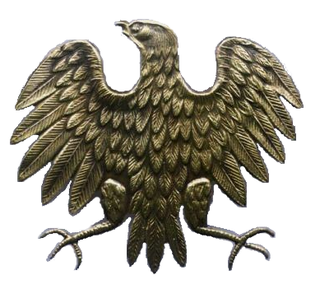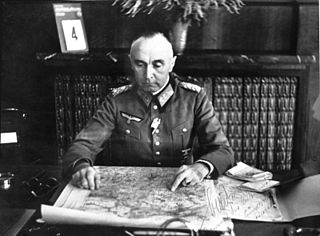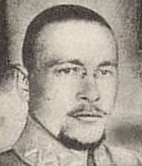Related Research Articles

Dęblin is a town at the confluence of Vistula and Wieprz rivers, in Lublin Voivodeship, Poland. Dęblin is the part of the agglomeration with adjacent towns of Ryki and Puławy, which altogether has over 100 000 inhabitants. The population of the town itself is 15,505. Dęblin is part of the historic region of Lesser Poland. Since 1927 it has been the home of the chief Polish Air Force Academy, and as such Dęblin is one of the most important places associated with aviation in Poland. The town is also a key railroad junction, located along the major Berlin – Warsaw line, with two additional connections stemming from Dęblin – one westwards to Radom, and another one northeast to Łuków.

The 4th Panzer Division was an armored division in the Army of Nazi Germany.

Bolesław Bronisław Duch (1896–1980) was a Polish Major General and General Inspector of the Armed Forces.

Władysław Bortnowski was a Polish historian, military commander and one of the highest ranking generals of the Polish Army. He is most famous for commanding the Pomorze Army in the Battle of Bzura during the invasion of Poland in 1939. He is also notable for serving as president of the Józef Piłsudski Institute of America between 1961 and 1962.

Wincenty Kowalski (1892–1984) was a Polish military commander and a general of the Polish Army. A veteran of both World War I and World War II, he fought in all the inter-war conflicts of Poland. During the Invasion of Poland of 1939 he commanded the Polish 1st Legions Infantry Division.
The Battle of Kałuszyn, took place between 11 and 12 September 1939 around the town of Kałuszyn near Mińsk Mazowiecki in Poland. It was part of the invasion of Poland at the start of World War II between forces of the Polish Army and the invading German Army.
The 19th Infantry Division of the Polish Army was established in 1923 after the incorporation of Central Lithuania into Poland. It was part of the Prusy Army during the German-led Invasion of Poland. Later during the war, in the summer of 1944, the division was recreated as a Home Army unit, taking part in the Operation Ostra Brama in the summer of 1944.

The Polish Armed Forces in the East, also called Polish Army in the USSR, were the Polish military forces established in the Soviet Union during World War II.
Polish 2nd Legions Infantry Division was a tactical unit of the Polish Army between the World Wars. Formed on February 21, 1919, in the towns of Zegrze and Jablonna near Warsaw, and composed mostly of veterans of the Polish Legions in World War I, the unit saw extensive action during the Polish-Bolshevik War and the Invasion of Poland.
The 6th Rifle Division was an infantry division of the Soviet Union's Red Army. Formed multiple times, it participated in several battles, most notably the Soviet westward offensive of 1918–1919, the Estonian War of Independence, the Polish–Soviet War. In the latter war, the division was severely defeated by Polish troops. The division's first formation was awarded the Order of the Red Banner twice and the Order of Suvorov 2nd class for its valor in combat. In November 1945, the division was disbanded. It was briefly reformed in 1955 but disbanded again in 1957.
The 55th Infantry Division was a reserve unit of the Polish Army during the interbellum period, which took part in the Polish September Campaign. Commanded by Colonel Stanislaw Kalabinski, it was part of Operational Group Silesia of the Kraków Army.

15th "Greater Poland" Infantry Division was a unit of the Polish Army in the interbellum period. Founded on February 17, 1920, and based on the 2nd Greater Poland Rifles Division, it actively participated in the Polish-Soviet War, including the Kiev offensive (1920), and the Battle of Warsaw. After Polish victory, the Division pushed the Red Army out of northern Mazovia. It then fought in the Battle of the Niemen River.

5th Lwów Infantry Division was a unit of the Polish Army in the interbellum period, with headquarters stationed in Lwów. It was created on May 20, 1919, during the Polish–

Polish 24th Infantry Division was a unit of the Polish Army in the interbellum period, which took part in the Polish September Campaign. The Division was created in 1921, and its first commandants were: General Jan Hempel, General Wacław Scaevola-Wieczorkiewicz, Colonel Boleslaw Maria Krzyzanowski, and Colonel Boleslaw Schwarzenberg-Czerny. The 24th Division's headquarters were located in Jarosław, with some regiments stationed in nearby cities of Rzeszów and Przemyśl. It consisted of:
The 27th Rifle Division was a tactical unit in the Red Army of Soviet Russia and then the Soviet Union, active between 1918 and 1945. First formed during the Russian Civil War on November 3, 1918, as part of 5th Red Army. Commanded by Vitovt Putna, it was transferred to the 16th Red Army in 1920, and took part in the Polish–Soviet War. Defeated in the battles of Radzymin and Ossów, it practically ceased to exist.

Paul Bader was a General der Artillerie of the Wehrmacht during World War II who commanded the 2nd Motorized Infantry Division in the invasions of Poland and France then served as a corps commander and as Military Commander in Serbia. During his time in occupied Yugoslavia troops under his command engaged in several major anti-Partisan operations, within both the Territory of the Military Commander in Serbia and in the Independent State of Croatia.

Bruno Edward Olbrycht was a soldier of the Austro-Hungarian Army and officer of the Polish Army both in the Second Polish Republic and postwar Poland. Born on 6 October 1895 in Sanok, Austrian Galicia, Olbrycht fought in Polish Legions in World War I, Polish–Ukrainian War, Polish–Soviet War and the Invasion of Poland. He died on 23 March 1951 in Kraków.
The 262nd Rifle Division was an infantry division of the Red Army during World War II.
The 97th Rifle Division was thrice formed as an infantry division of the Red Army, first as part of the prewar buildup of forces. The first formation was based on the pre-September 1939 shtat and the division was initially intended to serve in the fortifications along the border with Poland in western Ukraine. Beginning on September 17, 1939 it took part in the invasion of eastern Poland and then was moved north to join the 7th Army and later the 13th Army on the Karelian Isthmus during the Winter War against Finland where it saw action in the latter part of the struggle. Following this it returned to western Ukraine where it was on the border at the time of the German invasion in June 1941. At considerable cost it was able to retreat back to the Dniepr River south of Kiev during July and was still there as part of 26th Army when the Soviet forces in eastern Ukraine were largely surrounded and wiped out in September. The division was finally disbanded in late December.
References
- 1 2 "Poland case study". 2019-06-21. doi:10.18356/d988d68a-en. S2CID 128917883 . Retrieved 2021-06-02.
{{cite journal}}: Cite journal requires|journal=(help)